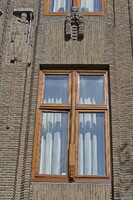| dc.coverage.spatial | Site: Amsterdam, North Holland, Netherlands | en_US |
| dc.coverage.temporal | 1912-1916 (creation) | en_US |
| dc.creator | Klerk, Michel de | en_US |
| dc.creator | Meij, J. M. van der | en_US |
| dc.creator | Kramer, Pieter Lodewijk | en_US |
| dc.date | 1912-1916 | en_US |
| dc.date.accessioned | 2014-12-22T16:28:46Z | |
| dc.date.available | 2014-12-22T16:28:46Z | |
| dc.date.issued | 1912-1916 | en_US |
| dc.identifier | 254398 | en_US |
| dc.identifier.other | archrefid: 3054 | en_US |
| dc.identifier.uri | http://hdl.handle.net/1721.3/170004 | |
| dc.description | Detail of one window frame and terra cotta decoration; With P. L. Kramer, in 1913 de Klerk began to work with J. M. van der Meij (also rendered Van der Mey), who had the commission for the Scheepvaarthuis in Amsterdam. Within a year de Klerk and Kramer had designed the decorative façade for the skeleton of reinforced concrete, the first large manifestation of the Amsterdam school. An architect named A.D.N. van Gendt was responsible for engineering the concrete structure. The Scheepvaarthuis was a large cooperative building for six Dutch shipping companies. Van der Meij's job was to coordinate the extensive symbolic art and sculptural program for the prow-shaped building, inside and outside. Much of the sculpture is the work of Hildo Krop and H.A. van den Eijnde, but a large group of well-known artists contributed. The building is now a hotel (2007, The Grand Hotel Amrath), although architectural tours are still given. The conversion used the former offices for hotel rooms, but has preserved the rest of the structure and decorations. Source: Grove Art Online; http://www.oxfordartonline.com/ (accessed 7/13/2014) | en_US |
| dc.format.medium | reinforced concrete; stained glass; brick; stone; wrought iron; wood | en_US |
| dc.rights | © Scott Gilchrist, Archivision, Inc. | en_US |
| dc.subject | architecture | en_US |
| dc.subject | business, commerce and trade | en_US |
| dc.subject | decorative arts | en_US |
| dc.subject | Restoration and conservation | en_US |
| dc.subject | Amsterdamse School | en_US |
| dc.subject | shipping | en_US |
| dc.subject | maritime motifs | en_US |
| dc.subject | Amsterdam school | en_US |
| dc.subject | Twentieth century | en_US |
| dc.subject | Expressionist | en_US |
| dc.title | Scheepvaarthuis (Shipping House) | en_US |
| dc.type | image | en_US |
| dc.rights.access | Licensed for educational and research use by the MIT community only | en_US |
| dc.identifier.vendorcode | 1A2-N-A-SH-A31 | en_US |
| vra.culturalContext | Dutch | en_US |
| vra.technique | construction (assembling), carving (processes), modeling (forming) | en_US |
| vra.worktype | office building | en_US |
| dc.contributor.display | J. M. van der Meij (Dutch architect, 1878-1949); Michel de Klerk (Dutch architect, 1884-1923); Pieter Lodewijk Kramer (Dutch architect, 1881-1961) | en_US |

